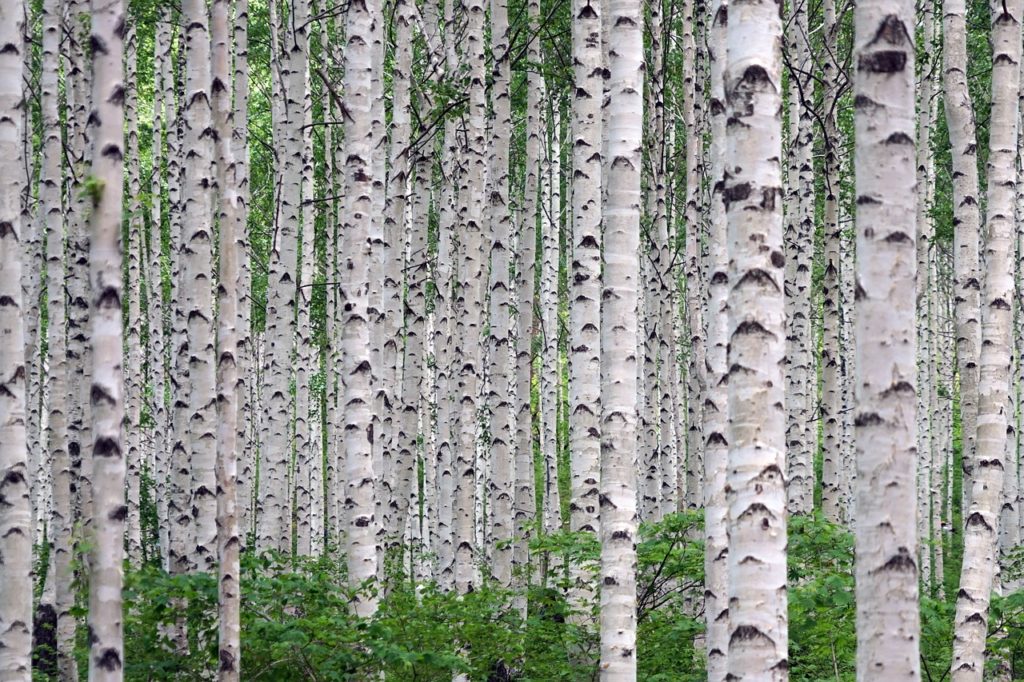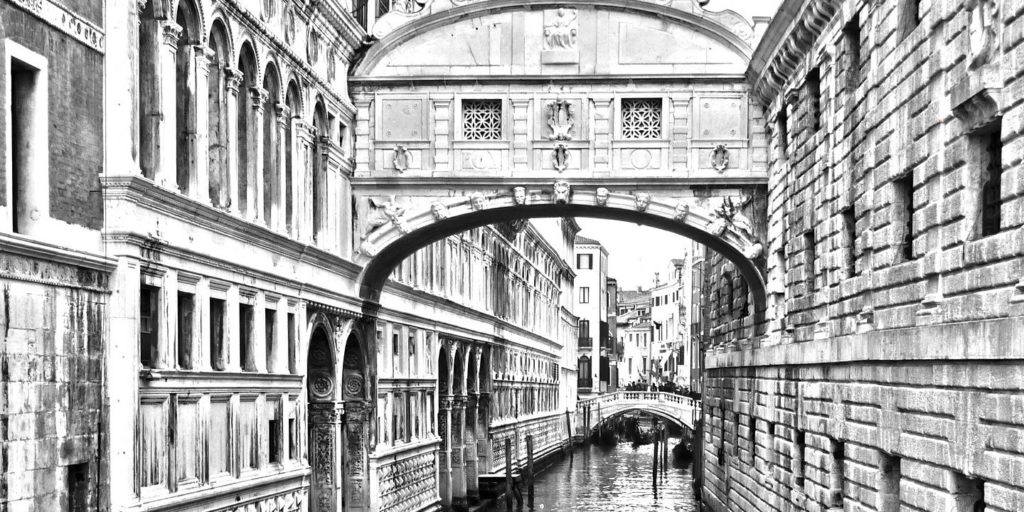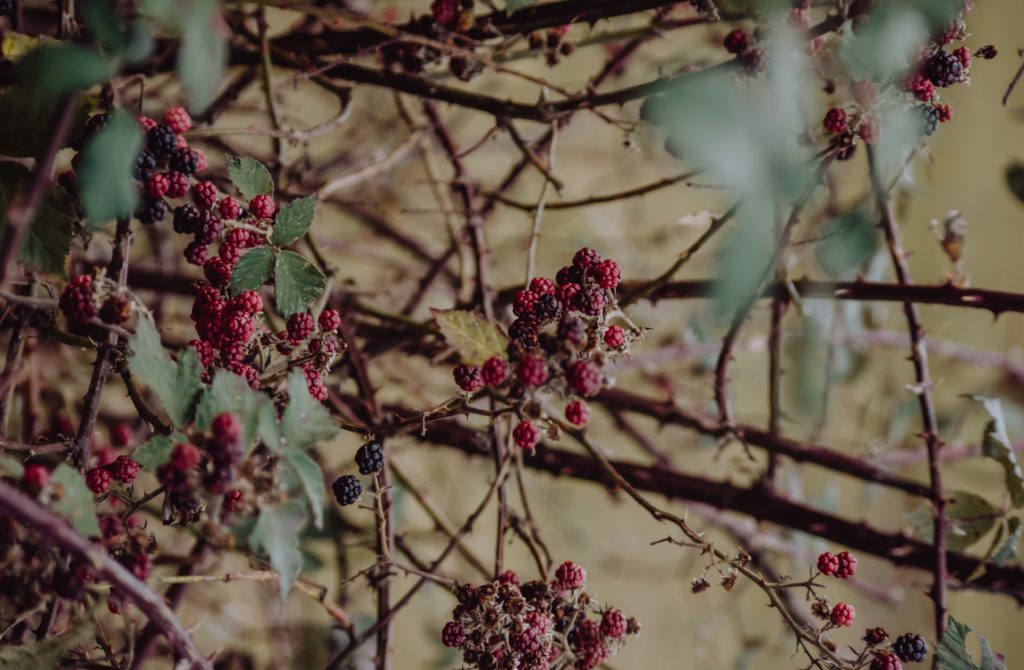The better I prepare to leave the house, the sturdier my boots, the more comprehensively I study the map, the greater the number of raincoats, sweaters, hats, gloves, scarves I pack, the more often I get lost. So often has this happened that I’m convinced the only possible way to get lost is if one is prepared in every way not to. Yet whenever I find myself caught in a downpour in the middle of a foreign city, wearing shorts and a t-shirt, with no knowledge of the local language, no phone battery, and no idea how to get back to my hostel, I somehow always end up where I need to be. It’s only when I’m close to home that I’m ever truly lost.
I am walking on Wimbledon Common along a familiar path, only to find before long it leading away from where I’m sure it goes, conducting me somewhere utterly unrecognisable. Alders reach overhead silencing the sunlight; thorny canes knot themselves around my ankles and alder limbs greet me wearing woollen mittens and a beanie, one carrying a canvas bag, another keeping itself warm with the scarf looped around its trunk. I take the mitten offered in welcome; it is small, too small for my hand, loosely woven and rough with shed leaves.
The lost things stowed on branches by later passers-by are almost always childish and as every child knows, losing is all too easy. My old bedroom had pine floorboards that had warped over time, leaving gaps through which I was always afraid of dropping things. Whenever I couldn’t find a pen, sweet, or toy, I dreaded it had disappeared between the pines and was now part of the house itself. But walking on the common and coming across the lost objects there, a stranger fantasy strikes me: might my lost things have picked up and found their way here instead? Practically any piece of junk has a lifespan exceeding its inventor’s and, left without them, can acquire sudden new possibilities. I’ve seen fruit, tubes of Pringles, gaudily illustrated calendars, crockery, and ceramic foxes all offered at Buddhist shrines – trivial objects on supermarket shelves but when placed on an altar, imbued with holy power.

∆
The Schatzkammer in Vienna; the monasteries of Santo Toribio de Liébana in Cantabria, Spain; Gishen Debre Kerbe Mariam in Ambassel, Ethiopia and hundreds of other sites, all claim to possess pieces of the True Cross on which Jesus himself was crucified. Jean Calvin sardonically commented, ‘There is no abbey so poor as not to have a specimen…if all the pieces were collected together, they would make a shipload. Yet the Gospel testifies that a single man was able to carry it.’ Many more relics besides have multiple, or if sole then dubious, claimants: the Holy Lance which pierced Christ’s side, his foreskin, Saint Anthony’s arm, the stones that battered St Stephen to death, even the slab on which Roman soldiers played dice for Christ’s garment. Almost certainly not a single one of these items is genuine; the cult of relics peaked one-thousand years after Christ’s death, long before archaeology had established scientific procedures. Pieces of the True Cross would have been dug straight from the ground – former scaffolding, planks, and crutches rendered divine. Christian relics then, share with Buddhist offerings their origin in the everyday: both begin as something trivial. What differentiates them comes once the relic has been unearthed. The Christian works to conceal the relic’s trivial origins; the Buddhist shrine elevates them.
Related ways of thinking, even among the secular, circle when someone dies. When we were clearing my maternal grandfather’s house of a lifetime’s possessions after he died a decade ago, it was clear how to deal with valuable items like Chinese silk screens and crystal glasses whose inheritance was pre-arranged. But what about his teaspoons, shirts, ties, garden furniture? These items lacked a sense of grandfatherliness; it was not that we had never seen him use a teaspoon, sit in the garden, or wear a suit, but that we had seen him do these things so often that the objects lacked the special colouring of memory. Try as I might I could not recall a concrete image relating to any of them. Holding, from among many typical leftovers, a teaspoon with a pelican-embossed pommel, I realised that in fact I hadn’t really known him all that well, hoped that there were things I could still find out about him, things I could only find out now that he was dead, and that passed-over objects like this teaspoon were the vehicles through which such private discoveries might be made.
It has been ten years since I carried that teaspoon home and I’m still waiting for my madeleine moment. Proust says the past is ‘hidden’ in ‘some material object’, but also that retrieving it is ‘beyond the realm of the intellect’ and comes only by chance. Actively seeking is ‘a labour in vain’. There was a point when I believed I had succeeded; I recalled sitting outside with my grandfather, drinking tea and sharing a slice of his favourite coffee and walnut cake, which he was spooning into his mouth with the same spoon now in my drawer. Only, I know he could not have managed a crumbly cake with such a small spoon using his own curled, stiffened fingers. I had willed myself into fantasy where reality could only come unwilled. Nevertheless, the portal opened by my attempts felt like access to a new world in which only I and my grandfather lived, a world that only a trivial object like the teaspoon could have enabled. Monumental objects, which his silk screen and crystal glasses had become because they were memorable, have a verifiable public history that disallows one’s own imagination from lending them a secret second life.
I was reminded of my attempts to use a teaspoon as a time-machine during my visit to Rachel Whiteread’s retrospective at Tate Britain in 2017. She casts the negative space within, around, and in between objects, rendering air itself solid; so her ‘torsos’, which appear to be plaster replicas of hot water bottles and enema bags are in fact casts of their empty interiors. Many pieces, which at first glance resemble ordinary domestic objects, reveal, on continued looking, uncanny differences from what our eyes expect: the light switches in Untitled (Twenty Four Switches) are not in relief but depressed into the console and cannot be turned on or off; her ‘torsos’ are solid plaster, impermeable to flowing water; we see the imprints of pages on her bookshelves but no books. By ‘mummifying air’ Whiteread blocks off our habitual interpretative pathways. This thing half-resembling a hot water bottle refuses to evoke shared ideas of warmth, homeliness and comfort; instead it reminds me of a private memory, of waking up with my toes scraping a cold brick at the bottom of my bed. Bricks were used instead of hot water bottles when I stayed in Guillestre in the Hautes-Alpes as a child. Every morning, its oven-heat dissipated and with the chill outdoors having advanced into the bedroom, the brick would weigh down the mattress as if someone was sitting watching me sleep.
Whiteread’s miniatures render the gallery a chapel, with each viewer in private communion with each object as a worshipper contemplates an icon. But galleries and chapels are also public spaces; the objects within them can exploit as well as resist public interpretations. The work of Japanese sculptor Chiharu Shiota does just this, by forming a broader sense of connective understanding around everyday items chosen for their archetypal, often mythical associations. Unlike Whiteread, she never displays her objects alone, intertwining things such as keys, shoes, doors, and boats, within hand-weaved yarn webbing that reaches to the gallery’s ceiling and walls. Webs are networks whose function depends on interrelations: to survive, a spider must correctly read vibrations sent out by floundering prey. We are ourselves webbed by miles of arteries, veins and capillaries resembling Shiota’s red yarn. Likewise, her selected objects embody connection and lack meaning alone: a shoe needs a foot, a key needs a door, a boat needs a passenger.
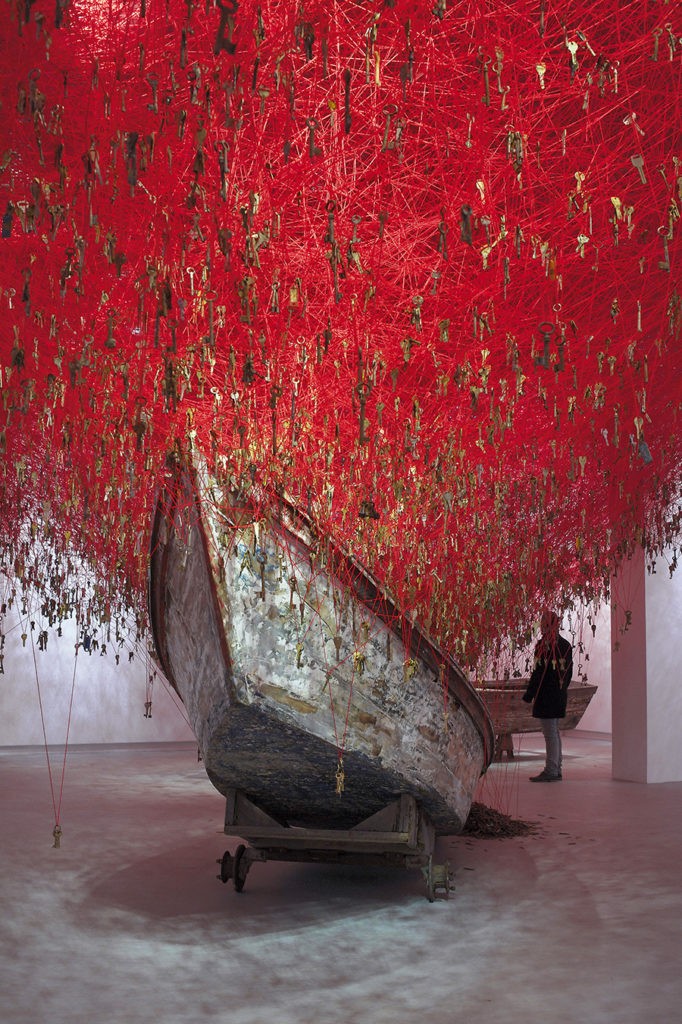
In The Key in the Hand two wooden skiffs sit glowering on the gallery floor, while, rising from their empty hulls, criss-crossing threads of red yarn suspend hundreds of rusty keys. Moored on dry land, these empty skiffs at first suggest shipwreck and its most famous victim and archetype, Robinson Crusoe. The silent keys envy jangling pockets, within which lie the keys to a home, something Crusoe was only able to simulate on his island. But if home is elsewhere, perhaps the boats are not stranded, are in fact waiting to be crewed so that their passengers might lay hold of the keys just out of reach overhead, and strike out in search of doors. Such a journey could be an escape, like Aeneas’s; or like Odysseus’s, a long-delayed return. Shiota weaves an intertextual web with her archetypal objects; keys and boats evoke shared myths, maintained by a shared imagination. Such an imagination is required to see the True Cross in a shard of wood; ostentatious decorations have been grafted onto these shards in order to ‘fill in the gaps’ – take a look at the Schatzkammer fragment, a rectangular plank inlaid into a gold frame so as to resemble a crucifix. It was a mutual excess of belief that bejewelled these fragments, giving them significance far beyond their material worth. Likewise Shiota’s work may be no more than a few junk items and threads of yarn, but knitted together overhead they imply a protective, overarching forest and the possibility of getting lost.
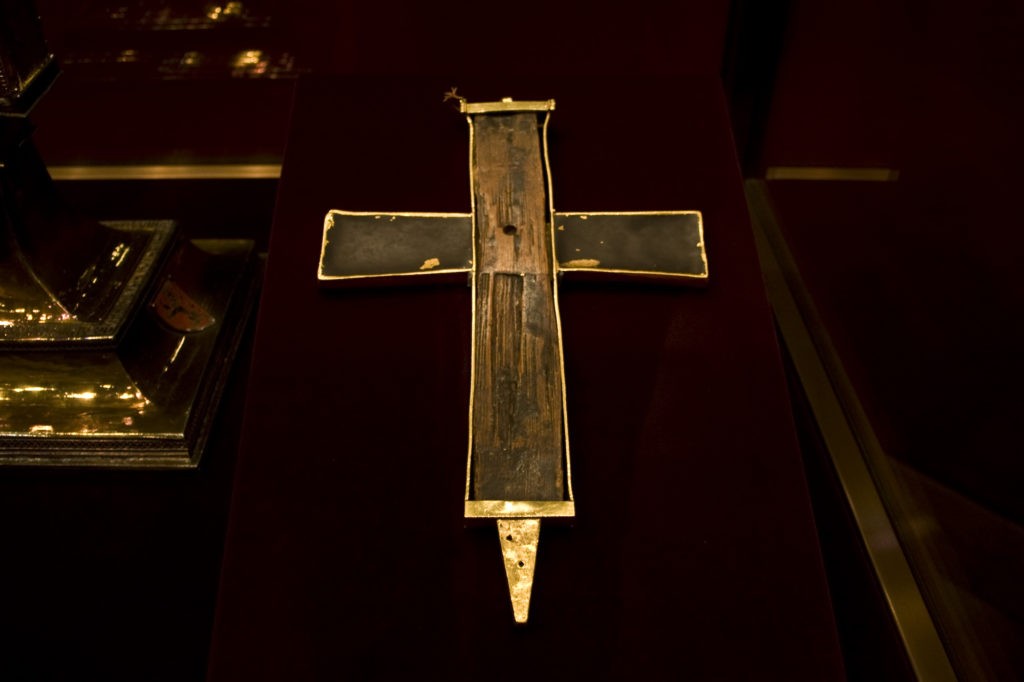
The wooded areas of Wimbledon Common like prehistoric forests, share the silence of churches, graveyards, and museums. If fifty thousand years from now humans are extinct and woodland covers the earth, what objects might be left among the trees? The pyramids will blow through the Sahara, the Channel Tunnel drift beneath the Atlantic. Human beings have only one monument nearing immortality: plastic. McDonald’s freebies, six pack beer rings, disposable nappies, fishing line will endure, intertwined with tree roots and coral reefs, and perhaps incorporated into flesh itself.
Bridging divergent forms of matter has been a constant human dream: it is there in communion, when we expect bread to transform into Christ’s body; at shrines where we expect grapes to nourish spirits; in my hope that a spoon could revive my grandfather. Today Elon Musk’s company Neuralink is attempting to upload consciousness onto computer networks. But in their human-centeredness both modern and ancient efforts overlook the synthesis happening before our eyes: neither consciousness nor spirit is merging with flesh; plastic is. A 2016 study found that plastic is present in a third of UK fish; this might be a death knell, it might also be the beginnings of a new stage of evolution, surely a force too malleable and too fecund to be snapped by human efforts.
The ‘Age of Plastic’ envisaged in 1941 by chemists Victor Yarsley and Edward Couzens imagines a future in which ‘the plastic man will come into a world of colour and bright shining surfaces where childish hands find nothing to break’; once he is old he will ‘wear a denture with silent plastic teeth and spectacles with plastic lenses…until at last he sinks into his grave in a hygienically enclosed plastic coffin.’ We each have a coffin awaiting us; plastics do not. They will endure here long after us. They may become Here itself. Perhaps the geriatric’s ‘silent plastic teeth’ will not be installed but will grow from soft tissue gums. The ‘world of colour’ will be wrested from the manmade and trees will grow red plastic branches with fibrous green leaves; crabs will be housed in plastic shells, fish will swim by means of plastic fins. Perhaps this is what the forests of Wimbledon Common, their trees littered with lost things, dream of when they sleep.
A rabbit flits through the brambles as I replace the woollen mitten on a branch. I pull apart the overlapping canes, taking care not to prick myself, and go on. The light blinds after the dark, but somehow, I find myself back on a path whose end I think I know.
Mathis Clément is a founding editor of Moxy, freelance writer, and tutor. His work has appeared in the London Magazine, Review 31, and the Isis. A version of this piece was published in the London Magazine June/July 2019 print issue.

